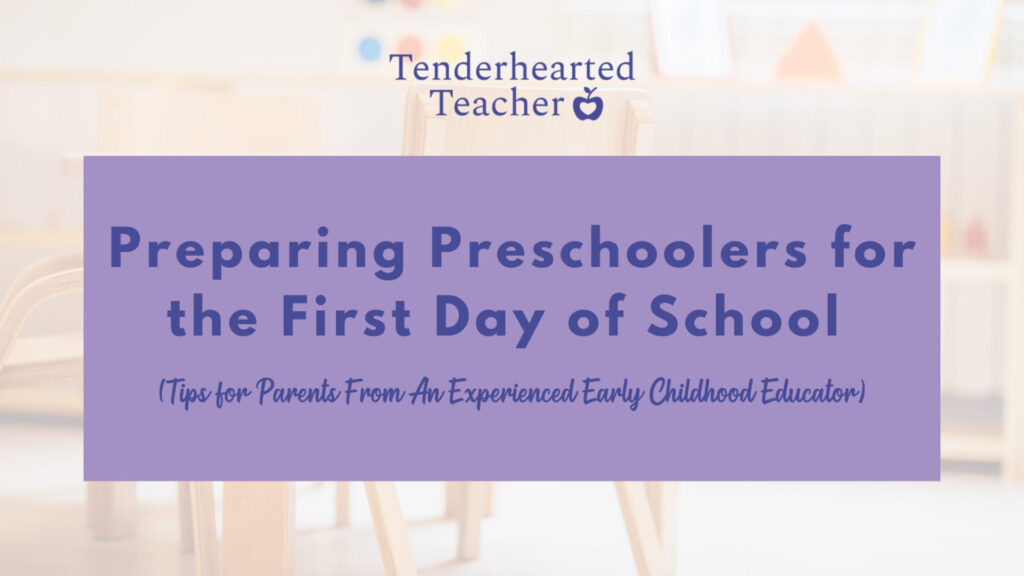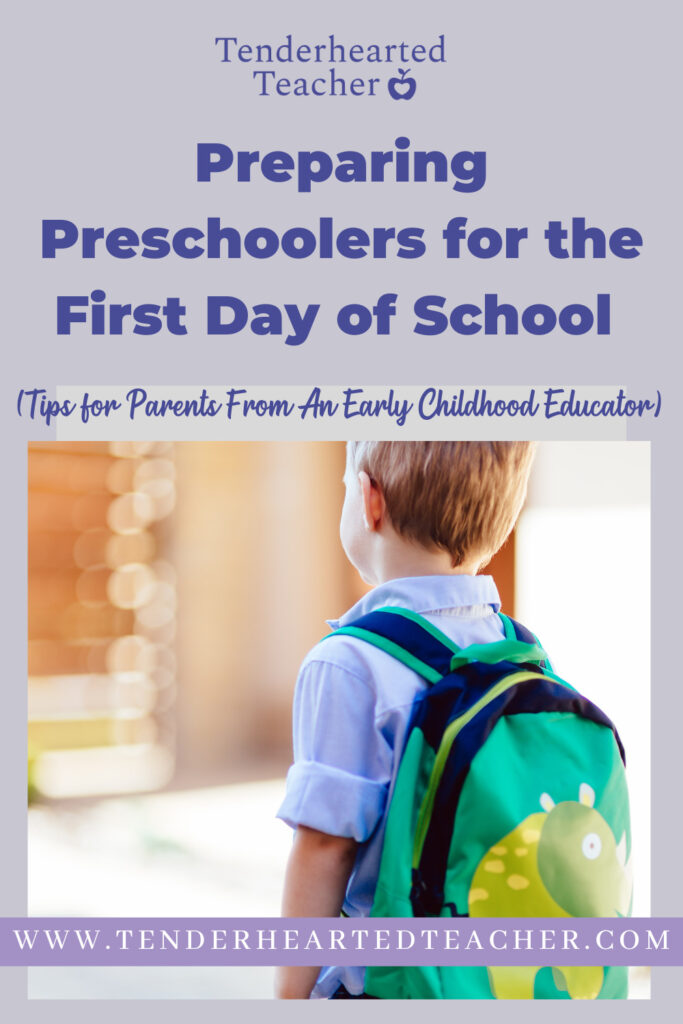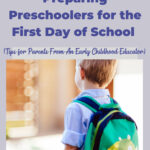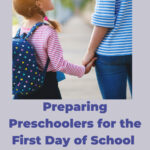
Please note: This post contains affiliate links. As an Amazon Associate, I earn from qualifying purchases. Therefore, if you buy something through these links I will receive a small commission at no extra cost to you. Thank you for your support.
Sending our kiddos to school for the first time can be exciting, but also a little daunting. We may have feelings of apprehension about how things will play out. But, as adults, our anxieties are usually quelled by knowing the benefits and positive impacts of early childhood programs on our children and their overall development. We can’t wait to see them have new experiences, gain knowledge and skills, and form friendships. For young children, on the other hand, new places, faces, and changes in routines can bring some jitters. With that said, there are things that you can do to help ease this transition for your little one (and for yourself!) This blog post features tips and resources for preparing preschoolers for the first day of school.
I’ve also created a free printable with the first day of school signs in case you’d like to take some pictures to remember the big day! Scroll down to download your copy!
Tips and Resources for Parents and Caregivers
The key to a successful and smooth start to school is to prepare, prepare, prepare. You can do this a few weeks or days ahead of time. Here are some steps you can take to help navigate this period with your child. These are some of the things I did with my own child before he started nursery school.
1. Lay The Groundwork
Don’t wait until the day of to let your child know they’ll be going to school. Instead, have daily conversations leading up to the event so they know what to expect. You can even keep track on a calendar and do a countdown to the first day. Then talk to them about school, what happens there, how long they’ll be there, who will pick them up, who their teacher will be, the types of activities they’ll do, etc. I’d recommend reaching out to your child’s teacher to ask for a copy of the typical schedule so you can review it with your little one. Also, if your school has an open house, let them visit the classroom beforehand too. If not, take a walk or drive by the school and point it out to your child so they know what their school looks like.
2. Discuss Their Emotions
Ask your child about how going to school makes them feel. If they are feeling nervous, don’t downplay or dismiss their feelings. Validate any and all feelings. Let them know that it’s okay to feel nervous when facing a big change. You can even share a personal story about your own school experience or a time when you’ve overcome nerves. Read more about how to encourage social-emotional development here.
Additionally, you can use different games, activities, or props to help your child express and manage their feelings. For example, you can draw pictures, write in a journal together, and/or use an emotions check-in chart or flashcards. Check out my Etsy shop, by clicking below, for products you can use with your little one.

3. Make Things Fun
There are many books and songs out there to help your child become familiar with what to expect from a typical school day as well as those that help to calm their jitters.
Here are some book recommendations for preparing preschoolers for their first day of school:
- Used Book in Good Condition
- Hardcover Book
- Dewdney, Anna (Author)
- English (Publication Language)
- 40 Pages - 03/19/2009 (Publication Date) - Viking Books for Young Readers (Publisher)
- Hardcover Book
- McQuinn, Anna (Author)
- English (Publication Language)
- 32 Pages - 06/11/2019 (Publication Date) - Charlesbridge (Publisher)
- Dean, James (Author)
- English (Publication Language)
- 24 Pages - 06/18/2019 (Publication Date) - HarperCollins (Publisher)
- Penn, Audrey (Author)
- English (Publication Language)
- 32 Pages - 08/04/2020 (Publication Date) - Tanglewood (Publisher)
- Hardcover Book
- Willems, Mo (Author)
- English (Publication Language)
- 40 Pages - 07/02/2019 (Publication Date) - Hyperion Books for Children (Publisher)
- Hardcover Book
- John, Jory (Author)
- English (Publication Language)
- 40 Pages - 07/07/2020 (Publication Date) - Dial Books (Publisher)
And here are a few songs as well:
4. Set Up A Routine
According to Zero to Three, “Consistent routines, activities that happen at about the same time and in about the same way each day, provide comfort and a sense of safety to young children.” So it is important to set up a typical daily routine for wake-up, mealtime, getting dressed, etc. You should establish this routine several days before starting school so that it can become second nature. It’s also a good idea to make a visual aid like a chart or social story so you and your child can review it together each day. Additionally, let your child pick out their outfit and prepare their belongings the night before to give them a sense of responsibility and build up their excitement for the following day!
5. Include A Familiar Item
When you’re packing up your child’s backpack make sure to place a family photo in their folder. This special memento will make it feel like you’re a part of their day and you’re still with them. Also, let the teacher know it’s in there too. This way if your child is feeling separation anxiety they can look at the photo for comfort.
Things to Avoid At Drop-Off
One of the most common questions I get, from the parents of prospective students, is how to avoid the dreaded tears when it’s time to say goodbye at drop-off. First, start by knowing that separation anxiety in young children is normal and to be expected. So, you may not be able to completely avoid the tears altogether. If your child is crying, there are a few things you want to avoid:
- Steer clear of bribes and promises like “if you stop crying, I’ll get you a cookie!” This can only reinforce this type of behavior.
- Resist the urge to remove them from the building or the classroom. If you do this it will make it that much more difficult to get them in and settled. Preschool teachers deal with this type of situation every single school year so follow their lead.
- Finally, don’t sneak out without a goodbye because this could make your child even more upset.
Establishing a Goodbye Routine
As I mentioned before, Zero to Three states, “Routines provide the two key ingredients for learning: relationships and repetition.” Therefore, all drop-offs (those with tears and those without) benefit from a consistent routine to help your child acclimate and feel comfortable in their new surroundings.
With that said, here are my suggestions for your drop-off routine. Calmly say goodbye, tell them you hope they have a great day, and remind them that you’ll be back at pick-up time before making your exit. With my own son, we have a goodbye sequence we follow: “high-five, fist-bump, kiss, goodbye.” We do it at nap time, bedtime, and when we’re leaving him with a babysitter. It works like a charm. Try it with your little one!
Also, as someone who has been working with preschoolers for more than a decade, I want to provide a little bit of reassurance. In my experience, 90% of children stop crying within 5 minutes of getting into the classroom. They quickly adjust once they are surrounded by new friends and toys.
I should note, however, that separation anxieties can occur after the initial drop-off — even with children who go in smoothly on the first day. So in those cases, it’s important to remain consistent with your drop-off routine and to continue the preparation strategies mentioned earlier.
In Conclusion
Preparing your preschooler for the first day of school can be stressful for parents and children. However, it doesn’t need to be! By following these tips, you can enjoy this exciting new experience together.
And don’t forget to download your free first day of preschool sign here. I’ve included a sign for the last day as well because I love to compare the beginning and end of the year photos to see how much they’ve grown! This free printable includes preschool, pre-k, and nursery school versions (depending on your child’s setting.) There are also versions for you to write in your child’s name.
Now talk to me! Do you have any tips, suggestions, or routines for preparing preschoolers for the first day of school? Comment below.
SAVE TO PINTEREST











Great tips. Love the one about discussing emotions – we have this daily with our little one each morning before nursery.
And the videos are great!!